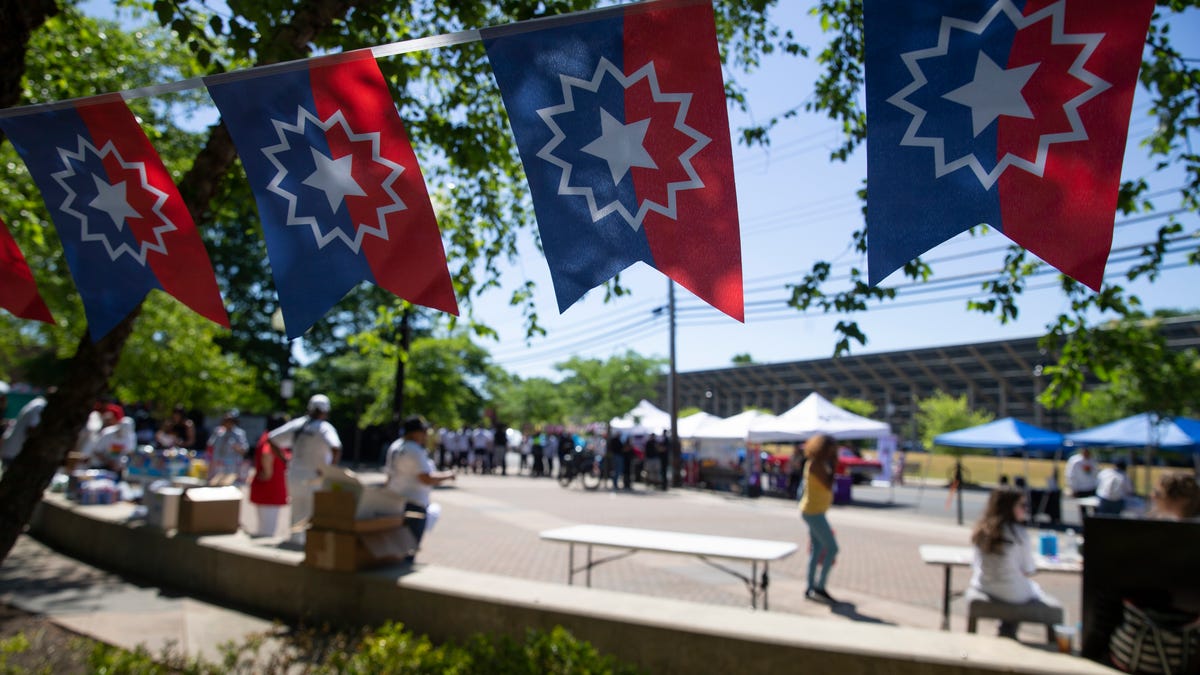Indianapolis, IN
In Indianapolis, whether you’re evicted or not can depend on where you live
On a cold November Monday when the temperature dipped below freezing, Austin Jensen was sweating in a threadbare white T-shirt. He rushed to move his partner, Reeda Raney, himself, and their three rescue pups out of their westside home by 5 p.m. or be evicted.
He flipped a 100-pound dresser on his shoulder and hauled it down the stairs onto the tailgate of Raney’s mom’s pickup truck. Glenda Dillon, Raney’s mother, felt helpless. All she could do was hold the door. She lives in a mobile home park and could not offer them shelter.
“No mama wants to see her daughter sleep in a car,” Dillon said to Raney. Shivering in 20-degree blustering winds, Raney said she had no idea where they would sleep that night.
In the past year, 27,727 Indianapolis residents have had evictions filed against them, according to the eviction tracking database Eviction Lab. In a city that has the fifth-highest eviction filing rate nationwide, according to Eviction Lab, the answer to solving Indianapolis’ eviction crisis may come from the very authorities who order the evictions: Indianapolis’ nine townships’ small claims courts judges.
The judge in Wayne Township eviction court, Gerald Coleman, had given Jensen 11 days to move out or be slapped with an eviction, a scarlet “E” that would hurt his chances of finding a home again.
Had Jensen and Raney lived in a different township, they might have had as long as 21 days.
Indianapolis tenants facing eviction can see vastly different outcomes in eviction court, depending on in which township they live.
That’s because Marion County’s court system is the only one in Indiana where township courts have jurisdiction over evictions. Nine separate courts hear eviction cases, one in each of the townships’ small claims courts, each with a different elected judge, each with their own interpretations of the law.
“There are serious constitutional due process concerns when court parties’ rights vary so widely depending on which side of the street the rental property is located on,” Indiana University housing law expert and pro bono tenant attorney Fran Quigley said. “That kind of disparity leaves tenants believing that justice is arbitrary and more connected to the preferences of the judge in front of them than the facts and law that apply to their case.”
Advocates, court watchers and tenant attorneys say the vast disparities between Indianapolis eviction courts are confusing at best and unfair at worst.
At one extreme is Wayne Township, where Coleman, as a self-declared matter of practice, usually gives tenants five days to vacate. At the other end of the spectrum is Lawrence Township’s Judge Kimberly Bacon, who gives tenants 21 days. Other courts fall somewhere on the spectrum in between.
Carolyn Kingen, an eviction court watcher from a housing justice task force organized by Meridian Street United Methodist Church, told IndyStar the way that evictions in Wayne Township’s court are handed out so speedily seems like a “factory production.” Other judges approach proceedings with what she considered to be more grace and flexibility, such as Warren Township’s Judge Garland Graves who she said almost always inquires about the reason for a tenant being behind on their rent and tries to keep tenants housed.
Other disparities between courts include how quickly an eviction moves through court, whether a judge orders late fees to be waived, and how tenants are treated.
Some township courts offer significant eviction diversion resources and housing navigation help; others don’t. Judges also approach hearings differently: in some courts, like Wayne Township, they often only last two to five minutes. In other courts, judges spend triple that time.
The disparities also extend to how likely the judges are to allow eviction cases to be sealed. Sealing a case helps tenants as new prospective landlords won’t see the eviction on their record.
Wayne Township had the lowest percentage of eviction cases sealed, 29%, of all eight Indianapolis township courts that had more than one eviction sealing case filed by Indiana Legal Services between Nov. 2022 and May 2023, according to an IndyStar analysis of data provided by the nonprofit. All other townships had eviction sealing rates of above 40%, with all except Perry Township having a rate above 58%.
Each of Indianapolis’ township judges has different practices.
“We do have discretion and I believe that discretion should be exercised appropriately and reasonably,” Coleman told IndyStar. “There’s the possibility of abusing discretion too when you go a little bit too far. But that is a question of judgment.”
Coleman told IndyStar that he generally gives tenants five days, more than the state-mandated minimum, because that was the norm in Wayne Township Small Claims Court when he took office in 2015. But he said he may vary how much time he gives tenants depending on their circumstances, such as if a disabled tenant needs more time to move out.
When Bacon took the bench in 2015, the standard was to give tenants five to seven days, she told IndyStar. But, she said, she found that most people who fall behind on rent are unable to recover within that short time.
She started granting tenants three weeks to give people more time to save up, collect one or two more checks from work, pay rent, and stay.
“It is, in my opinion, a bigger issue,” she told IndyStar. “This is the kind of court that can begin a cycle of instability and poverty.”
By extending the time a tenant is given to pay their outstanding rent before they have to move out, courts can reduce the number of evictions.
“(W)e want to avoid creating homelessness,” Bacon said. “Destabilizing one’s housing can potentially destabilize more than just one individual.”
Raney has never asked for help before. She spent years managing fleets of trucks. She had planned to retire comfortably but her heart had different ideas. Hit with stage four congestive heart failure in 2019, she now relies on $1,400 a month in disability benefits.
She and Jensen had high hopes in October when they moved into the peaceful cul de sac on the westside with a dog park for their pups. But the day after they moved in, Jensen’s work doing waste management dried up. The couple fell two months behind on rent. Their landlord filed for an eviction.
The difference between staying in your home and homelessness could be mere days
Indiana eviction law, which some have called landlord-friendly, is notoriously weak in tenant protections. The law only requires tenants be given 48 hours to move out after a judge grants a landlord possession of a property, although the time can be shorter if the case is considered an emergency. Local rules only mandate tenants be given 10 days’ notice between when an eviction is filed and when a hearing is scheduled.
Jensen and Raney had been counting on finding rent money before the court-mandated move out date. But with just 11 days, three of which were holidays when the township trustee’s office was closed, that was not much time at all.
Meanwhile, their car had two broken ball joints that cost $1,400 to fix. They decided to pay for the repairs instead of rent because they needed a car to drive around to find work.
Raney’s disability check, which could have helped pay the $3,500 that they owed in rent, wasn’t coming until Friday, four days after Coleman’s ordered move out date.
They applied for rental assistance at the Wayne Township Trustee’s office on Oct. 30 and were denied because they didn’t have the required documents. They were in the middle of an appeal when Coleman ordered the eviction. The appeal failed a week before they had to leave their home.
After the judge ordered them out, the trustee’s office on Nov. 20 offered to help pay for a week’s worth of hotel housing. But the trustee’s office wound up denying them assistance because of a miscommunication between township trustee staff and Raney.
“I have never had to ask anyone for help before,” Raney said. “When I do, I get the runaround….Being poor and being on this side of it, they don’t have a lot of care and concern.”
The same day Jensen and Raney were ordered out, another tenant was evicted in Wayne Township by his landlord who claimed the tenant’s name was not on the lease. The tenant, representing himself, insisted he was on the lease but didn’t bring a copy of the lease to court. The landlord, represented by an experienced attorney, had.
“You know you’re coming into court today. You need to bring your evidence,” Coleman said to the tenant.
Coleman added, “If we just gave defendants another day to present evidence, we’d never get through trials.Coleman gave the tenant five days to move out voluntarily or the landlord would be allowed to evict them.
Tenants have vastly different experiences in different eviction courts
Jensen’s hearing in Wayne Township eviction court on Nov. 16 lasted three minutes. Those three minutes would send two lives into a tailspin over the next weeks, if not years.
Over the course of half an hour that Thursday morning, all but one eviction hearing lasted less than five minutes, with one tenant only appearing for 90 seconds before Coleman ordered him out within five days. A hearing for a terminally ill woman in the hospital who had stopped paying rent lasted three-and-a-half minutes. She also got five days.
IndyStar asked Coleman why he often makes final decisions within minutes in an initial eviction hearing.
“Because the law is clear,” Coleman said. “If you’re behind your rent and the landlord requests possession, they’re going to get that under the law. There’s no need for an initial hearing in that situation. We know what the issues are.”
But some say that there often are deeper issues at play and speedy eviction hearings can violate a tenant’s right to due process.
The lightning-fast speed of many eviction hearings, attorneys and court watchers said, stems in part from the tsunami of cases that courts hear on a single day.
On Thursday mornings, the day that Coleman usually schedules eviction hearings, courtroom hallways are crowded elbow-to-elbow.
Quigley said that evictions are incredibly fast and cheap to obtain in Indiana, in part because of how most judges treat the initial hearing, which is the first time a tenant comes to court, as an “all-or-nothing” situation, a “full-blown trial.”
This date can be as little as 10 days after a tenant is first notified of the eviction filing.
“The better practice, and some judges do this, is to treat it as an initial hearing,” Quigley said.
If there is a dispute about whether the tenant is behind on rent or if the tenant has justified reasons for not paying rent, he said, the case should be set for a contested bench trial after the initial hearing.
“Pretending that a docket with dozens and dozens if not hundreds of cases on it in a single afternoon is enough time for people to have their rights fully protected is a travesty,” Quigley said.
One housing law expert said she thinks the problem extends well beyond Indianapolis to the entire state’s landlord-tenant court system.
“I’m struggling to find words to convey how brutal, inhumane, uncivilized and evil the system is,” said Florence Roisman, an Indiana University housing law professor. “It is a collection agency for landlords. It has nothing to do with law or justice. The people who administer it should not be called judges.”
A recent Court of Appeals of Indiana ruling illustrates one of the problems. The higher court found that the Center Township Small Claims Court violated a tenant’s due process rights by rushing through an eviction hearing without giving the tenant a chance to prepare and defend herself against allegations.
In the opinion, the court wrote that the case reflected longtime concerns about due process protections in eviction cases.
“A crowded docket does not excuse a small claims court from depriving a litigant of her due process rights,” the opinion read.
Lawrence Township eviction court focuses on eviction diversion
Across the city from Wayne Township eviction court, the day before Jensen was ordered out, Bacon, the judge of Lawrence Township small claims court, was hearing eviction cases. The average eviction hearing that morning was significantly longer than in Wayne Township, lasting 12 minutes.
Before court began, Cheryl Johnson, a court navigator hired by a grant that Bacon obtained in 2022 from the National Center for State Court’s Eviction Diversion Initiative, spoke to tenants about resources available to help them stay in their homes.
“I’m a resource. I help you find resources,” she told the roomful of people.
After court began, Bacon made it clear to tenants that if they deny any of the allegations a landlord made, the case would move to a contested bench trial. Tenants need time to gather their evidence, she told IndyStar, because for many it is their first time in court and they may not understand the process.
“Oftentimes, they are in what I consider a fight or flight mode where they are fighting to maintain their house and may not have had a chance to formulate their thoughts or arguments,” she said.
Bacon hired a court facilitator with the grant and said that has also helped improve the eviction dismissal rate.
“Having a resource or somebody to reach out to, to help direct you in the right direction is invaluable,” she said.
The Indianapolis Bar Foundation is providing a grant to six small claims courts to set up an eviction navigation program similar to Lawrence Township’s, Bacon said. All township courts except Wayne Township and Perry Township are participating.
Standardizing court procedures around evictions would level the playing field, said Judge Robert Altice of Indiana’s Court of Appeals second district in Central Indiana.
“It tells each of the parties the rules,” Altice said. “It certainly encourages tenants to come into court when they know what the procedure is.”
Moreover, said Altice, standardized rules across courts can prevent forum shopping, the practice of attorneys choosing a court that is thought to be most likely to provide a favorable judgement. The problem, Altice said, is that eviction cases can either be filed in the township court where the rental home is located or Marion County Superior Court. He said that some landlord attorneys who dislike the process in township courts have been filing for eviction in Superior Court because they think those judges might favor them.
“At a minimum, there should be county-wide standards on the timelines for scheduling hearings and the time periods for tenants to move if they are court-ordered to do so,” Quigley said. “Better yet, we should follow the lead of many other metropolitan areas and have a county-wide housing court.”
Marion County courts would have to agree to such a change or the Indiana General Assembly could change eviction laws.
Allen County Superior Court in October 2022 instituted an eviction protocol to ensure judges hearing eviction cases follow similar rules.
The protocol mandates that tenants be notified at least 20 days prior to the initial hearing and that the initial hearing be in person with the landlord, tenant and an eviction diversion facilitator.
Judge Jennifer DeGroote of Allen County, who developed the protocol, said one goal is to reduce the number of evictions by prolonging the eviction process, giving tenants and landlords time to work it out.
Altice, who works as a liaison between Indianapolis’ small claims courts and the Indiana Court of Appeals, said that he has been working with the small claims courts to explore how to standardize eviction proceedings.
Coleman said consistency makes sense to a degree.
“It can be confusing when you have same circumstances and different outcomes,” he said.
But, he added, judges’ must have discretion to tailor decisions according to each case.
Outside the home where Jensen and Raney had lived, the truck was fully loaded with their belongings, ready to be taken to a 10 by 28 foot storage unit. Raney hugged her mom tightly.
“Not at all how I saw my life going at 49 years old,” she told IndyStar. “But it is absolutely day to day living now.”
Raney thinks that they will land on their feet; they always do. They’ve been through tough times before. But that night and for the rest of the week, they had to sleep in their car parked on a dirt road, huddled with their dogs, Riley, Maxwell, and Carly, for warmth.
IndyStar photojournalist Mykal McEldowney contributing reporting. Contact him at mykal.mceldowney@indystar.com.
Contact IndyStar reporter Ko Lyn Cheang on X at @kolyn_cheang.

Indianapolis, IN
Cooler temperatures, rain chances return Tuesday afternoon | May. 27, 2025

INDIANAPOLIS (WISH) — Below-normal temperatures will persist over the next few days. The pattern will turn much warmer as we head into the new month of June this weekend.
Tuesday:
A cloudy, cool, and at times damp weather pattern will continue as we return to work for the short week. Expect mostly cloudy to completely overcast skies at times during the day. Scattered showers will develop heading into the afternoon hours.
High temperatures will struggle, only reaching the mid to upper 60s this afternoon.
Tuesday night:
Showers and a few thunderstorm chances will continue into the overnight hours. For most areas, rainfall should be relatively light, but heavy downpours are possible with any embedded thunderstorms.
Overnight lows will fall into the mid-50s.
Wednesday:
The wet weather pattern will persist with considerable cloud cover, slightly warmer temperatures, scattered showers, and a few thunderstorms on Wednesday afternoon. High temperatures will top out near 70°F.
Late week:
A nearby system on Thursday could bring shower chances to parts of the state, though it remains unclear how close the system will get. Many areas will likely stay dry as temperatures begin to moderate, reaching the mid-70s on Thursday and Friday.
Isolated showers and possibly a few thunderstorms are possible on Friday and heading into the weekend. The last day of May on Saturday should be very warm, with highs in the mid to upper 70s.
Seasonable, if not warmer-than-average, temperatures will continue into June, with highs near 80°F on Sunday and lower 80s by Tuesday. The 8-to-14-day forecast also indicates warmer-than-normal temperatures over the next couple of weeks.
Indianapolis, IN
The winners and losers from a wet and wild 2025 Indianapolis 500

There’s nothing like the Month of May at Indianapolis Motor Speedway — and rarely has the Indianapolis 500 been more eventful than the iconic event’s 2025 edition.
Ran on a cool Indiana day amid overcast skies and occasional spurts of rain, the race’s 109th running was briefly delayed and then immediately chaotic, hit with attrition before the green flag could even fly.
That set the stage for a race that saw numerous plot twists, comers and goers as attrition, strategy and the usual luck of the Indy 500 played out for 200 painstaking laps.
Here’s a look at the winners and losers from the Greatest Spectacle in Racing.
Winner: A new Indy 500 champion is crowned: Alex Palou
Alex Palou, Chip Ganassi Racing
Photo by: Brandon Badraoui / Motorsport Images via Getty Images
Yep. He did it, again.
For the past few years, Alex Palou has been a beast on road-and-street circuits. But ovals were a weakness, offering intermittent chances for the field to close ground in the championship fight.
If Sunday’s result is any indication, that’s no longer the case. Palou exorcised his oval demons with his first win and did it at the biggest race of them all, sweeping the Month of May with his first triumph in the Indianapolis 500.
He now leaves the Month of May an Indy 500 champion, with a provisional 118-point advantage in the championship standings. Short of an injury or historic collapse, it’s unlikely that anyone will chase down Palou for the Astor Cup this season.
Loser: Marcus Ericsson (and everyone else)

Marcus Ericsson, Andretti Global
Photo by: Michael L. Levitt / Motorsport Images via Getty Images
He was right there — in an ending where passing proved challenging, Marcus Ericsson held the lead into the closing stretch. But he wound up losing the top spot to Palou and couldn’t get it back.
So Ericsson – like the 31 competitors that finished behind him – was left wondering what could have been at day’s end, even if the runner-up result was his best since the 2024 Detroit Grand Prix.
Winner: Lead changes aplenty at Indianapolis

Patricio O’ward, Arrow McLaren, Graham Rahal, Rahal Letterman Lanigan Racing, Colton Herta, Andretti Global, Callum Ilott, Prema Racing
Photo by: Michael L. Levitt / Motorsport Images via Getty Images
Blame it on Alex Palou’s dominance. Point the finger at the hybrid unit. Choose whatever reason you’d like. But by any measure, it had been a procedural affair up front for the IndyCar field in the season to date. There had been only two on-track passes for the lead beyond the opening corner in the eight road-and-street circuit races since the Hybrid unit was introduced in 2024 – including the opening five races of the 2025 season.
The Indy 500 matched that total just 12 laps into the race and proceeded to blow it out of the water. It wasn’t a spectacular race for the lead by Indy 500 standards, but a nice shakeup from the status quo beforehand.
Loser: Rossi, Veekay and Shwartzman end their days on pit road

Robert Shwartzman, Prema Racing
Photo by: Geoff Miller / Motorsport Images via Getty Images
Pit road is often treacherous at the Brickyard, but rarely does it claim victims in succession like it did in the middle portions of Sunday’s race.
Alexander Rossi came to pit road at the end of lap 73 after his car began smoking just to see a top-five run end in flames. Rinus Veekay was coming to pit minutes later on lap 81 when he lost control and slammed into the pit wall. Just six laps after that, pole-sitter Robert Shwartzman did the same while sliding into his box — and crew members — while the race was under caution.
Winner: A good day for David Malukas, AJ Foyt Racing

David Malukas, A. J. Foyt Enterprises
Photo by: Penske Entertainment
Prior to Sunday, it had been a quiet year for David Malukas. The Chicagoan had finished four of five races, but come home no better than 13th in a spring spent in the midpack. But on the day where the most eyes are drawn to IndyCar, Malukas made his presence known.
Piloting the No. 4, Malukas led two laps and found himself third in the race’s closing stages. The quirky ending behind lapped traffic meant that the top contenders stayed locked in place for the final 10 laps, keeping Malukas out of real contention for the win. But the third-place result was the 23-year-old’s best outside of World Wide Technology Raceway.
Teammate Santino Ferrucci didn’t supply many of the bold, exciting moves he’s managed in the past at Indianapolis. But the Connecticut native quietly marched up to seventh to give AJ Foyt Racing a pair of top-10s on the day.
Loser: Josef Newgarden’s three-peat attempt stalls

Josef Newgarden, Team Penske
Photo by: Brett Farmer / Motorsport Images via Getty Images
Josef Newgarden was ready to live up to the pressure of making potential history in Indianapolis. Unfortunately for the Tennessean, his car wasn’t as prepared.
The Team Penske ace was trying to set two historic firsts on Sunday — winning from the last row
And scoring a third-straight victory. And for a time, it seemed possible. Aided by the race’s heavy attrition and sporting a fast No. 2 Chevrolet, Newgarden rose up into the top-10 and had time to chase down the frontrunners for a chance at racing immortality.
But in the end, it wasn’t meant to be. Newgarden’s car lost fuel pressure and a trip to the pits on lap 135 ended with an early exit due to a fuel pump issue. Lady luck wasn’t on his side this year.
Winner: Solid days for title hopefuls

Christian Lundgaard, Arrow McLaren
Photo by: Brandon Badraoui / Motorsport Images via Getty Images
Look, the odds of anyone catching Palou at this point are slim. And no one is happy about any finish other than first at the Indy 500. But for those drivers hoping to catch him, or at least compete for second, bringing home a good result in an unpredictable race like Indianapolis is key.
So while top-10 runs for Pato O’Ward, Kyle Kirkwood, Christian Lundgaard and Felix Rosenqvist are nothing to write home about, they did help the group leave Indiana with the four spots behind Palou in the standings.
Loser: Mother Nature’s at it again

Indy 500 grid
Photo by: Phillip Abbott / Motorsport Images via Getty Images
It’s been a cool, overcast week in Indiana. So, there was no surprise when cloudy skies and a light threat of rain popped up on the race day forecast.
Thankfully, there was little rain to contend with on the day. But the little bit that did drop came down just as pre-race festivities were kicking into gear.
What ensued was a brief, but painful, wait as the weather moved through and the track dried – especially for Kyle Larson, who saw the little wiggle room he had for his planned IndyCar-NASCAR double evaporate as moisture hit his aeroscreen. Later, Larson’s race would end after an uncharacteristically botched restart.
That margin for error only got thinner from there, because rain forced a brief caution minutes later and before that…
Loser: Everyone loses their minds before the green

Marco Andretti, Andretti Global
Photo by: James Gilbert / Getty Images
It was shades of 1992 early on at Indianapolis.
By the time engines were fired and pace laps got underway, the capacity crowd at Indianapolis Motor Speedway had reached a fevered pitch. Emotions were high and drivers were ready to race.
In fact, they may have been a bit too ready.
The lone Team Penske driver that didn’t have to start from the rear, Scott McLaughlin, made a colossal mistake heading into turn 1 on the final lap before the scheduled green flag. The Kiwi was warming his tires when he lost control of his No. 3 Chevrolet and clobbered the inside wall at the end of the front stretch, bringing his race to an end before it could begin.
That led the race to start under caution. But the field still took the first green flag in the traditional three-wide formation, which led to another crash in turn 1 as Marco Andretti got the worst of a four-wide move.
The veteran’s 20th Indy 500 run was already hampered by a difficult qualifying weekend that saw him roll off 29th. But it ended even deeper in 32nd, having only seen one straightaway of green flag racing.
Scott Dixon wasn’t involved in an accident, but suffered a setback of his own. His car briefly went ablaze during the pace laps. The 2008 race winner eventually required a brake change as a result of the mechanical issue, trapping him three laps down and out of contention early in his 23rd Indy 500.
In this article
Be the first to know and subscribe for real-time news email updates on these topics
Indianapolis, IN
Full race results from the 109th running of the Indianapolis 500

Alex Palou has absolutely dominated the 2025 IndyCar season, winning five of the first six races, all while earning his first win in the Indianapolis 500.
The Chip Ganassi Racing driver passed Marcus Ericsson late, leaving him to finish second with David Malukas in third. Pato O’Ward and Felix Rosenqvist filled out the remainder of the top five for the 109th running of the Indy 500.
Palou is the first Spaniard to ever win IndyCar’s crown jewel event, getting it done in his sixth attempt.
Eleven drivers failed to finish the race, including Scott McLaughlin, who crashed out of the race in a shocking incident during the pace laps. Josef Newgarden did a great job charging from the last row on the grid, but his quest for the three-peat ended due to fuel pressure issues on his Team Penske Chevrolet.
Kyle Larson crashed out of the race on Lap 92 in a restart melee, and while he won’t be able to complete 1,100 miles, he will become the fifth driver to run the ‘Double’ as he heads to Charlotte for the 66th running of the Coca-Cola 600.
Rookie polesitter Robert Shwartzman never saw the finish either after being involved in a scary incident where he struck his Prema Racing pit crew. The top-finishing rookie was Louis Foster, who placed 15th.
2025 Indianapolis 500 Results
In this article
Nick DeGroot
IndyCar
Alex Palou
Chip Ganassi Racing
Be the first to know and subscribe for real-time news email updates on these topics
-

 World1 week ago
World1 week agoSevere storms kill at least 21 across US Midwest and South
-

 News1 week ago
News1 week agoWatch: Chaos as Mexican Navy ship collides with Brooklyn Bridge, sailors seen dangling – Times of India
-

 News1 week ago
News1 week agoMaps: 3.8-Magnitude Earthquake Strikes Southern California
-

 Politics1 week ago
Politics1 week agoTexas AG Ken Paxton sued over new rule to rein in 'rogue' DAs by allowing him access to their case records
-

 Politics1 week ago
Politics1 week agoAfghan Christian pastor pleads with Trump, warns of Taliban revenge after admin revokes refugee protections
-

 Politics1 week ago
Politics1 week agoTrump, alongside first lady, to sign bill criminalizing revenge porn and AI deepfakes
-

 World1 week ago
World1 week agoPortuguese PM’s party set to win general election, fall short of majority
-

 News1 week ago
News1 week agoVideo: One Person Dead in Explosion Outside Palm Springs Fertility Clinic



















